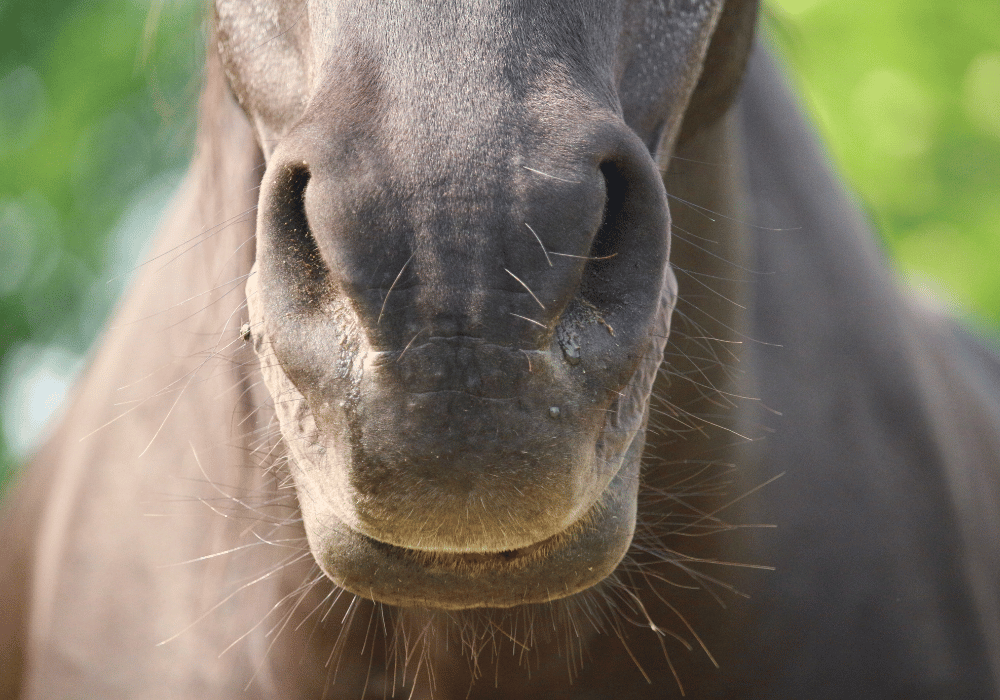Equine sinusitis is the most common disease affecting the paranasal sinuses in horses. It is an inflammatory condition involving excessive nasal discharge, often caused by another infection within the upper respiratory tract or a tooth root infection.
The condition can be primary or secondary, chronic or acute. Early and accurate diagnosis and treatment of the underlying cause are key. This guide outlines the symptoms, causes and treatments for equine sinusitis.
Symptoms of Equine Sinusitis
The clinical signs of sinusitis vary depending on the severity of the condition, whether the sinusitis is chronic or acute, and whether it is primary or secondary. The symptoms of sinusitis can include:
- Facial swelling
- Excessive tearing of the eye (epiphora)
- Reduced appetite
- Thick, green or yellow discharge from one nostril
- Foul-smelling discharge (usually in cases of secondary sinusitis)
- Abnormal respiratory noise
- Bulging of the eyes (exophthalmos) may be present when the sinusitis is caused by fungal infection or tumours
- Lethargy and weight loss tend to occur in cases of chronic sinusitis
Sinusitis will progress into a more severe infection if it is left untreated. If you notice pus or cloudy or abnormal discharge from one or both nostrils, call your equine vet to arrange an examination.
Causes of Sinusitis in Horses
Sinusitis can be primary or secondary. Primary sinusitis is an infection (usually bacterial) within the sinus, which results in a buildup of pus. Secondary sinusitis is more common, and is the result of another primary issue, such as a dental infection or cyst.
Primary sinusitis is often the result of an infection of the upper respiratory tract, or a virus that has not fully cleared. The lining of the sinus thickens, which obstructs the drainage of fluid, causing the sinus to become infected. This type of infection is often caused by Streptococcus bacteria.
Secondary sinusitis is usually dental-related. Most commonly, it is the result of an infection of the tooth roots. This type of infection usually involves the first molar, fourth premolar or the third premolar. It occurs when the roots, which sit in the sinuses, become infected, which causes the sinuses to fill with pus. Cysts and tumours (neoplasia) can also be responsible for secondary sinusitis. This is more common in older horses, and may cause facial swelling or distortion.
There are a number of less common causes of sinusitis in horses. These include:
- Progressive ehtmoidal haematoma (PEH)
- Trauma
- Open wounds on the face
- Post-operative complications from tooth repulsion surgery
- Destructive diseases of the sinuses
- Blockage of the passage between the front and back sinuses
- Adrenal tumours (in horses with PPID)
- Fungal infection (mycosis)
- Tissue death in the conchal sinuses
- Complications arising from long-term nasogastric intubation (this is uncommon)
Equine sinusitis can be acute (generally a more intense, but short-lived infection) or chronic (where lower-level sinusitis occurs more frequently). Symptoms of chronic sinusitis can worsen over time and it can be more difficult to treat.
Diagnosing Sinusitis
The key to diagnosing and treating sinusitis is identifying the underlying cause. Your vet will probably use a combination of the clinical signs, endoscopic findings and imaging tools to diagnose the type, cause and severity of sinusitis and recommend an appropriate course of treatment.
Your vet will assess the clinical signs and perform a physical examination in the first instance. This may involve percussion (tapping) of the bones over and around the sinuses to detect material within the sinuses. They may also carry out an oral examination to check for signs of dental infections.
In older horses, vets may examine the area where the hard palate and the maxillary cheek teeth meet. This is to check for squamous cell carcinoma, where tissue invades the nasal or sinus cavities.
X-ray, endoscopy or a CT scan may be used to check for the presence of pus, fluid, cysts or tumours within the sinus cavity.
A nasal endoscopy or sinoscopy may be carried out in order to visualise and assess the infection. Nasal endoscopy involves inserting a thin tube with a camera into the horse’s nasal passages to detect upper respiratory tract or guttural pouch infections, as well as to check for sinus abnormalities. Sinoscopy, or direct endoscopic evaluation, may be used to visualise, diagnose and treat the infection. It involves inserting an arthroscope or endoscope directly into the sinus cavity via a small hole in the head that is created by the vet. This procedure requires sedation and local anaesthesia.
Treating Sinusitis
Treating sinusitis effectively requires treatment of the primary cause of the infection. In cases where the sinusitis is caused by a tooth root infection, tooth extraction may be required.
A catheter may be used to drain the sinus of pus and fluid. This can take several days and require multiple treatments. Additional antibiotics and anti inflammatories are added to the sterile solution to help treat the infection.
In some cases, a sinus bone flap may be required. This may be used in the event of a tumour or in more severe cases of sinusitis. The procedure allows tissue to be surgically removed. However, sinus flap surgery requires an experienced veterinary surgeon in order to be performed safely and effectively. As with all surgical procedures, there is a risk of infection and complications.
Ongoing Management
Good management of your horse’s diet and environment can help minimise the likelihood of sinusitis. It is particularly important to minimise your horse’s exposure to airborne allergens and irritants after sinus surgery or treatment or in cases of chronic sinusitis.
A balanced, forage-based diet that is tailored to your horse’s individual needs can help to support the immune system and help the body fight off infections. Soaking or steaming hay and ensuring good ventilation at all times can help reduce the horse’s exposure to dust particles, which can irritate the sinuses. Constant access to fresh, clean water is also essential.
Avonvale Equine Vet Practice
Sinusitis can develop into much more serious conditions, such as chronic osteitis (infection of the bone), deep abscesses and tissue death if it is left untreated. Therefore, it is always important to call your vet if you notice pus or cloudy discharge from one or both nostrils.
Sinusitis is an example of why it is beneficial to have access to specialists in various areas of equine health. At Avonvale Equine Vet Practice, our equine vets bring a wealth of expertise to the table, including in equine dentistry, infectious diseases and surgery. Furthermore, our equine dental vets are able to carry out complicated dental surgery and extractions. Our vets work together to effectively diagnose and treat complex and varied conditions such as sinusitis. As well as having extensive knowledge and expertise, our vets are supported by full surgical facilities, diagnostic equipment and our in-house laboratory. Register your horse, pony, donkey or mule with us today.








